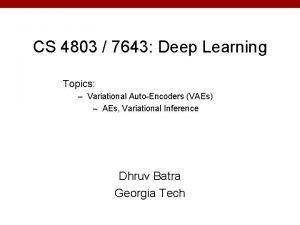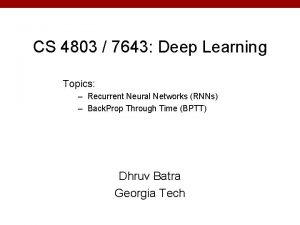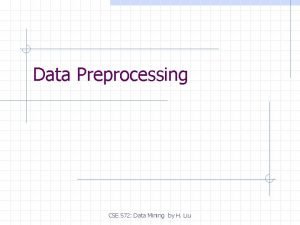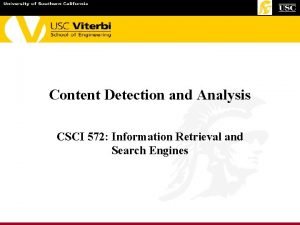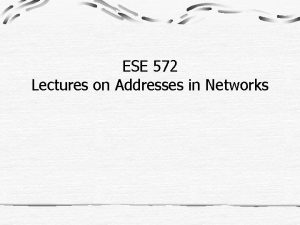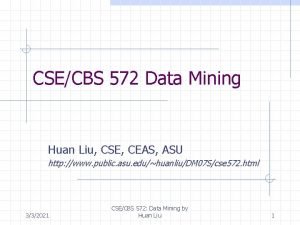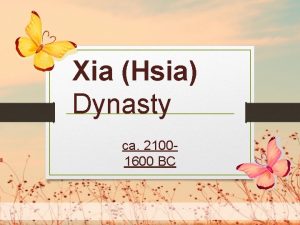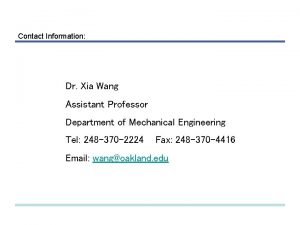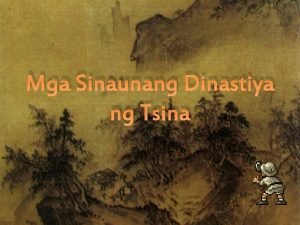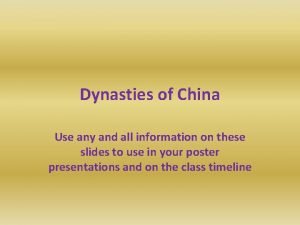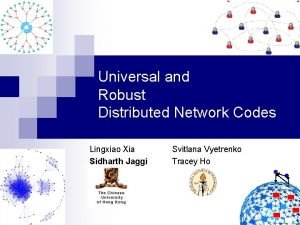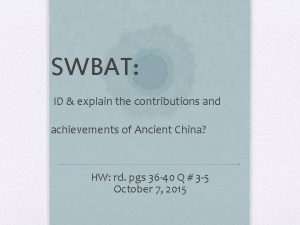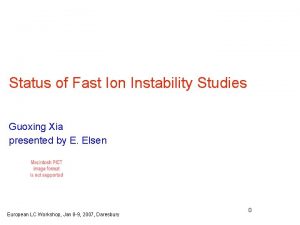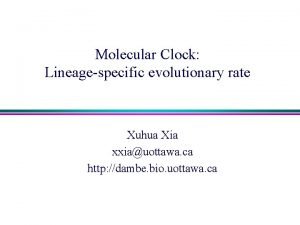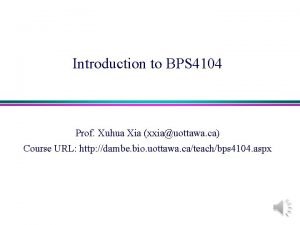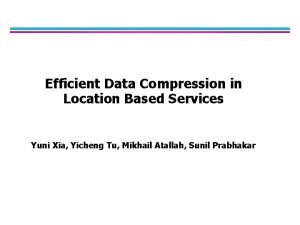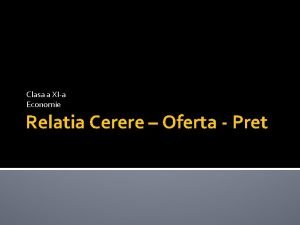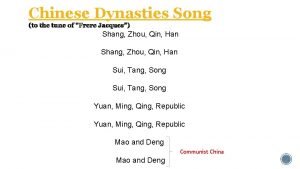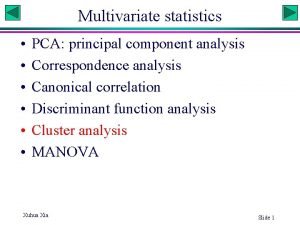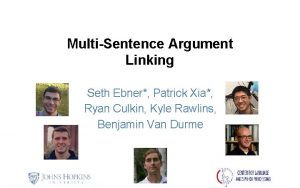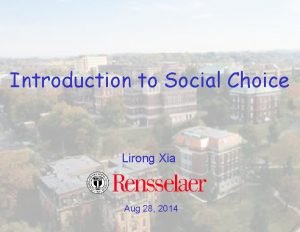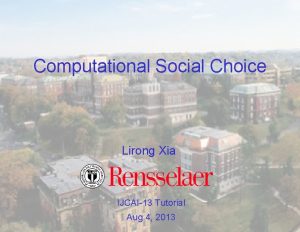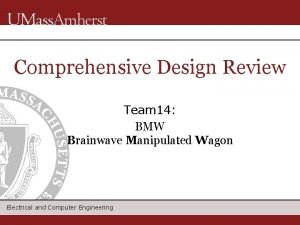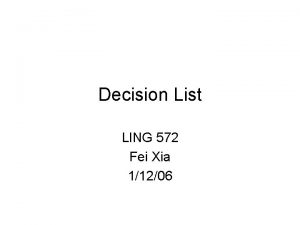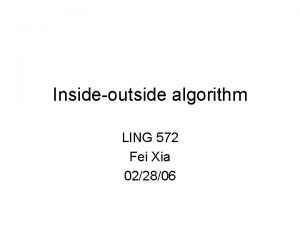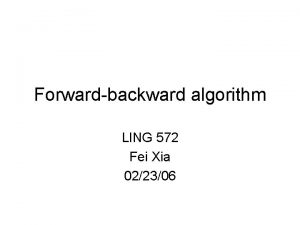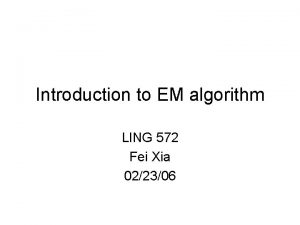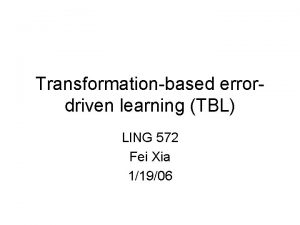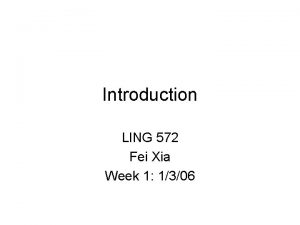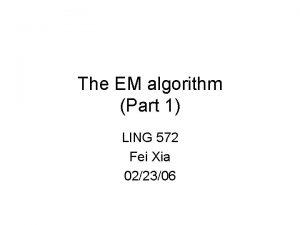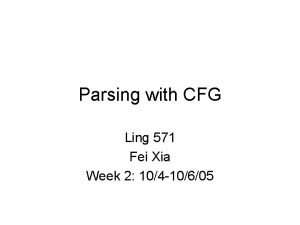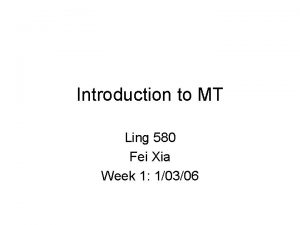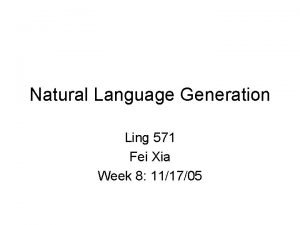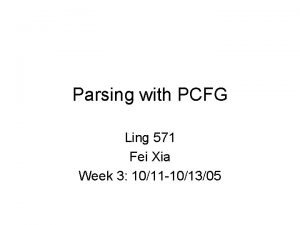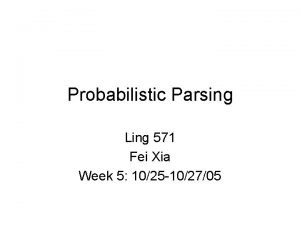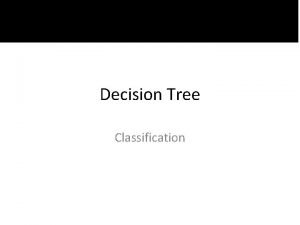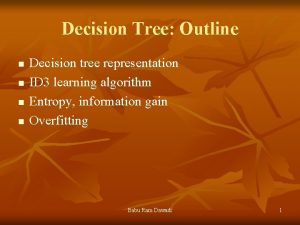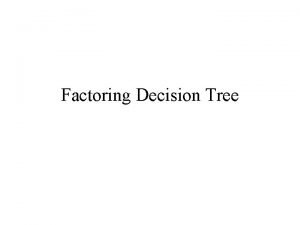Decision tree LING 572 Fei Xia 11006 Outline















![An example S=[9+, 5 -] E=0. 940 Humidity High Normal [3+, 4 -] E=0. An example S=[9+, 5 -] E=0. 940 Humidity High Normal [3+, 4 -] E=0.](https://slidetodoc.com/presentation_image/1c2d87943bb066e77931322c888b0248/image-16.jpg)


























- Slides: 42

Decision tree LING 572 Fei Xia 1/10/06

Outline • Basic concepts • Main issues • Advanced topics

Basic concepts

A classification problem District House type Income Suburban Detached Suburban Rural Urban … Outcome High Previous Customer No Semidetached High Yes Respond Semidetached Detached Low No Respond Low Yes Nothing

Classification and estimation problems • Given – a finite set of (input) attributes: features • Ex: District, House type, Income, Previous customer – a target attribute: the goal • Ex: Outcome: {Nothing, Respond} – training data: a set of classified examples in attribute-value representation • Ex: the previous table • Predict the value of the goal given the values of input attributes – The goal is a discrete variable classification problem – The goal is a continuous variable estimation problem

Decision tree n a b r u Sub ) 5 / 3 ( Urban (3/5) Previous customer ) /2 (2 3 ( s Ye No ) 3 / tac d Respond he Nothing Rural (4/4) Respond e -d mi Se /3) (3 De (2 tac /2 h ) ed House type District Nothing Respond

Decision tree representation • Each internal node is a test: – Theoretically, a node can test multiple attributes – In most systems, a node tests exactly one attribute • Each branch corresponds to test results – A branch corresponds to an attribute value or a range of attribute values • Each leaf node assigns – a class: decision tree – a real value: regression tree

What’s a best decision tree? • “Best”: You need a bias (e. g. , prefer the “smallest” tree): least depth? Fewest nodes? Which trees are the best predictors of unseen data? • Occam's Razor: we prefer the simplest hypothesis that fits the data. Find a decision tree that is as small as possible and fits the data

Finding a smallest decision tree • A decision tree can represent any discrete function of the inputs: y=f(x 1, x 2, …, xn) • The space of decision trees is too big for systemic search for a smallest decision tree. • Solution: greedy algorithm

Basic algorithm: top-down induction • Find the “best” decision attribute, A, and assign A as decision attribute for node • For each value of A, create new branch, and divide up training examples • Repeat the process until the gain is small enough

Major issues

Major issues Q 1: Choosing best attribute: what quality measure to use? Q 2: Determining when to stop splitting: avoid overfitting Q 3: Handling continuous attributes Q 4: Handling training data with missing attribute values Q 5: Handing attributes with different costs Q 6: Dealing with continuous goal attribute

Q 1: What quality measure • Information gain • Gain Ratio • …

Entropy of a training set • S is a sample of training examples • Entropy is one way of measuring the impurity of S • Pc is the proportion of examples in S whose target attribute has value c.

Information Gain • Gain(S, A)=expected reduction in entropy due to sorting on A. • Choose the A with the max information gain. (a. k. a. choose the A with the min average entropy)
![An example S9 5 E0 940 Humidity High Normal 3 4 E0 An example S=[9+, 5 -] E=0. 940 Humidity High Normal [3+, 4 -] E=0.](https://slidetodoc.com/presentation_image/1c2d87943bb066e77931322c888b0248/image-16.jpg)
An example S=[9+, 5 -] E=0. 940 Humidity High Normal [3+, 4 -] E=0. 985 [6+, 1 -] E=0. 592 Info. Gain(S, Humidity) =0. 940 -(7/14)*0. 985 -(7/14)0. 592 =0. 151 S=[9+, 5 -] E=0. 940 Wind Weak Strong [6+, 2 -] E=0. 811 [3+, 3 -] E=1. 00 Info. Gain(S, Wind) =0. 940 -(8/14)*0. 811 -(6/14)*1. 0 =0. 048

Other quality measures • Problem of information gain: – Information Gain prefers attributes with many values. • An alternative: Gain Ratio Where Si is subset of S for which A has value vi.

Q 2: avoiding overfitting • Overfitting occurs when our decision tree characterizes too much detail, or noise in our training data. • Consider error of hypothesis h over – Training data: Error. Train(h) – Entire distribution D of data: Error. D(h) • A hypothesis h overfits training data if there is an alternative hypothesis h’, such that – Error. Train(h) < Error. Train(h’), and – Error. D(h) > error. D(h’)

How to avoiding Overfitting • Stop growing the tree earlier – Ex: Info. Gain < threshold – Ex: Size of examples in a node < threshold –… • Grow full tree, then post-prune In practice, the latter works better than the former.

Post-pruning • Split data into training and validation set • Do until further pruning is harmful: – Evaluate impact on validation set of pruning each possible node (plus those below it) – Greedily remove the ones that don’t improve the performance on validation set Produces a smaller tree with best performance measure

Performance measure • Accuracy: – on validation data – K-fold cross validation • Misclassification cost: Sometimes more accuracy is desired for some classes than others. • MDL: size(tree) + errors(tree)

Rule post-pruning • Convert tree to equivalent set of rules • Prune each rule independently of others • Sort final rules into desired sequence for use • Perhaps most frequently used method (e. g. , C 4. 5)

Q 3: handling numeric attributes • Continuous attribute discrete attribute • Example – Original attribute: Temperature = 82. 5 – New attribute: (temperature > 72. 3) = t, f Question: how to choose thresholds?

Choosing thresholds for a continuous attribute • Sort the examples according to the continuous attribute. • Identify adjacent examples that differ in their target classification a set of candidate thresholds • Choose the candidate with the highest information gain.

Q 4: Unknown attribute values • Assume an attribute can take the value “blank”. • Assign most common value of A among training data at node n which have the same target class. • Assign prob pi to each possible value vi of A – Assign a fraction (pi) of example to each descendant in tree – This method is used in C 4. 5.

Q 5: Attributes with cost • Consider medical diagnosis (e. g. , blood test) has a cost • Question: how to learn a consistent tree with low expected cost? • One approach: replace gain by – Tan and Schlimmer (1990)

Q 6: Dealing with continuous goal attribute Regression tree • A variant of decision trees • Estimation problem: approximate real-valued functions: e. g. , the crime rate • A leaf node is marked with a real value or a linear function: e. g. , the mean of the target values of the examples at the node. • Measure of impurity: e. g. , variance, standard deviation, …

Summary of Major issues Q 1: Choosing best attribute: different quality measure. Q 2: Determining when to stop splitting: stop earlier or post-pruning Q 3: Handling continuous attributes: find the breakpoints

Summary of major issues (cont) Q 4: Handling training data with missing attribute values: blank value, most common value, or fractional count Q 5: Handing attributes with different costs: use a quality measure that includes the cost factors. Q 6: Dealing with continuous goal attribute: various ways of building regression trees.

Common algorithms • ID 3 • C 4. 5 • CART

ID 3 • Proposed by Quinlan (so is C 4. 5) • Can handle basic cases: discrete attributes, no missing information, etc. • Information gain as quality measure

C 4. 5 • An extension of ID 3: – Several quality measures – Incomplete information (missing attribute values) – Numerical (continuous) attributes – Pruning of decision trees – Rule derivation – Random mood and batch mood

CART • • CART (classification and regression tree) Proposed by Breiman et. al. (1984) Constant numerical values in leaves Variance as measure of impurity

Strengths of decision tree methods • Ability to generate understandable rules • Ease of calculation at classification time • Ability to handle both continuous and categorical variables • Ability to clearly indicate best attributes

The weaknesses of decision tree methods • Greedy algorithm: no global optimization • Error-prone with too many classes: numbers of training examples become smaller quickly in a tree with many levels/branches. • Expensive to train: sorting, combination of attributes, calculating quality measures, etc. • Trouble with non-rectangular regions: the rectangular classification boxes that may not correspond well with the actual distribution of records in the decision space.

Advanced topics

Combining multiple models • The inherent instability of top-down decision tree induction: different training datasets from a given problem domain will produce quite different trees. • Techniques: – Bagging – Boosting

Bagging • Introduced by Breiman • It first creates multiple decision trees based on different training sets. • Then, it compares each tree and incorporates the best features of each. • This addresses some of the problems inherent in regular ID 3.

Boosting • Introduced by Freund and Schapire • It examines the trees that incorrectly classify an instance and assign them a weight. • These weights are used to eliminate hypotheses or refocus the algorithm on the hypotheses that are performing well.

Summary • Basic case: – – Discrete input attributes Discrete goal attribute No missing attribute values Same cost for all tests and all kinds of misclassification. • Extended cases: – – – Continuous attributes Real-valued goal attribute Some examples miss some attribute values Some tests are more expensive than others. Some misclassifications are more serious than others.

Summary (cont) • Basic algorithm: – greedy algorithm – top-down induction – Bias for small trees • Major issues:

Uncovered issues • Incremental decision tree induction? • How can a decision relate to other decisions? what's the order of making the decisions? (e. g. , POS tagging) • What's the difference between decision tree and decision list?
 Fei fei li
Fei fei li Cs 7643 deep learning
Cs 7643 deep learning Objectives of decision making
Objectives of decision making Financial decision
Financial decision Tree in lung
Tree in lung Decision table and decision tree examples
Decision table and decision tree examples Chord apa yang disusun oleh nada 572
Chord apa yang disusun oleh nada 572 Cse 572 data mining
Cse 572 data mining Csci 572
Csci 572 Ese 572
Ese 572 Cse 572 data mining
Cse 572 data mining Find the odd one : 396, 462, 572, 427, 671, 264
Find the odd one : 396, 462, 572, 427, 671, 264 Dinastiyang hsia
Dinastiyang hsia Guoxing xia
Guoxing xia Tengbo li
Tengbo li Dr xia wang
Dr xia wang Chinese opera masks
Chinese opera masks Kontribusyon ng dinastiyang sui
Kontribusyon ng dinastiyang sui Xia dynasty government
Xia dynasty government Albert xia
Albert xia Xie gei tian shang de ni
Xie gei tian shang de ni Lingxiao xia
Lingxiao xia Zhou dynasty achievements
Zhou dynasty achievements Guoxing xia
Guoxing xia Ningxia red beneficios
Ningxia red beneficios Xuhua xia rate my prof
Xuhua xia rate my prof A xia
A xia Xuhua xia rate my prof
Xuhua xia rate my prof Adfreeze forces on piles
Adfreeze forces on piles Xia red
Xia red Yuni xia
Yuni xia Guoxing xia
Guoxing xia Cererea si oferta
Cererea si oferta Xia shang zhou qin han
Xia shang zhou qin han Amy xia amgen
Amy xia amgen Xuhua xia
Xuhua xia Perfume xia xiang
Perfume xia xiang Xỉa cá mè đè cá chép
Xỉa cá mè đè cá chép Multi-sentence argument linking
Multi-sentence argument linking Lirong xia
Lirong xia Lirong xia rpi
Lirong xia rpi Qiangfei xia
Qiangfei xia Xia bellringer
Xia bellringer
